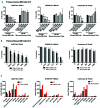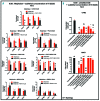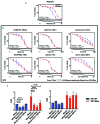Kinome expression profiling to target new therapeutic avenues in multiple myeloma
- PMID: 31289205
- PMCID: PMC7049359
- DOI: 10.3324/haematol.2018.208306
Kinome expression profiling to target new therapeutic avenues in multiple myeloma
Abstract
Multiple myeloma (MM) account for approximately 10% of hematological malignancies and is the second most common hematological disorder. Kinases inhibitors are widely used and their efficiency for the treatment of cancers has been demonstrated. Here, in order to identify kinases of potential therapeutic interest for the treatment of MM, we investigated the prognostic impact of the kinome expression profile in large cohorts of patients. We identified 36 kinome-related genes significantly linked with a prognostic value to MM, and built a kinome index based on their expression. The Kinome Index (KI) is linked to prognosis, proliferation, differentiation, and relapse in MM. We then tested inhibitors targeting seven of the identified protein kinas-es (PBK, SRPK1, CDC7-DBF4, MELK, CHK1, PLK4, MPS1/TTK) in human myeloma cell lines. All tested inhibitors significantly reduced the viability of myeloma cell lines, and we confirmed the potential clinical interest of three of them on primary myeloma cells from patients. In addition, we demonstrated their ability to potentialize the toxicity of conventional treatments, including Melphalan and Lenalidomide. This highlights their potential beneficial effect in myeloma therapy. Three kinases inhibitors (CHK1i, MELKi and PBKi) overcome resistance to Lenalidomide, while CHK1, PBK and DBF4 inhibitors re-sensitize Melphalan resistant cell line to this conventional therapeutic agent. Altogether, we demonstrate that kinase inhibitors could be of therapeutic interest especially in high-risk myeloma patients defined by the KI. CHEK1, MELK, PLK4, SRPK1, CDC7-DBF4, MPS1/TTK and PBK inhibitors could represent new treatment options either alone or in combination with Melphalan or IMiD for refractory/relapsing myeloma patients.
Copyright© 2020 Ferrata Storti Foundation.
Figures








References
Publication types
MeSH terms
Substances
LinkOut - more resources
Full Text Sources
Other Literature Sources
Medical
Miscellaneous

